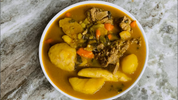
How to Make Bouillon: Traditional Haitian Soup in 2025
, by Seo Guy , 4 min reading time

, by Seo Guy , 4 min reading time
Haitian Bouillon is one of the country’s most beloved soups, a hearty dish filled with meat, root vegetables, dumplings, and leafy greens. Known for its richness and comforting flavors, Bouillon is not just a meal but a reflection of Haitian resilience and resourcefulness. It is enjoyed on weekends, at family gatherings, and during times when nourishment and warmth are most needed. Unlike lighter soups, Bouillon is a full meal in itself, offering sustenance and cultural pride in every bowl.
In 2025, Bouillon remains a cornerstone of Haitian cooking. For many Haitians abroad, preparing it is a way of bringing the warmth of home to new countries. It is also increasingly gaining attention in global food circles as a dish that balances nutrition, history, and tradition.
Bouillon stands out because it blends multiple elements into one pot. Its foundation is usually beef or goat, simmered until tender. To this base are added root vegetables like yam, malanga, cassava, and potatoes, along with leafy greens such as spinach or kale. Dumplings, called domplin, are made from flour and added to the broth, giving it a hearty texture. Seasonings like thyme, garlic, scallions, and Scotch bonnet peppers ensure the flavor is bold and unmistakably Haitian.
The result is a soup that is more like a stew—rich, filling, and packed with nutrients. Bouillon is meant to energize, nourish, and comfort, making it a favorite for Sunday family meals or special occasions.
Bouillon begins with marinating the meat in epis, the Haitian seasoning blend of herbs, garlic, onions, and peppers. The meat is browned and simmered until tender, creating a flavorful base. Vegetables are peeled, chopped, and added in stages to ensure everything cooks evenly. Dumplings are rolled and dropped into the simmering broth, where they absorb the flavors of the soup.
The cooking process is long and deliberate, often taking several hours, but the result is worth the effort. Families often prepare large pots so there is enough to share with relatives and neighbors. Bouillon is rarely made in small portions because its essence lies in bringing people together.
Bouillon is deeply tied to Haitian family life. On Sundays, families often gather around steaming bowls, sharing stories and laughter. It is also considered a restorative dish, prepared for those who are sick, tired, or in need of strength. In this way, Bouillon is more than food—it is medicine, comfort, and tradition combined.
During cultural events, Bouillon serves as a reminder of Haiti’s agricultural heritage. The use of root vegetables and greens reflects the connection between the land and the people, showing how Haitian cuisine makes the most of local ingredients.
For Haitians living abroad, Bouillon is one of the dishes most strongly associated with home. Whether in New York, Miami, or Montreal, Haitian families continue to cook Bouillon as a way of keeping traditions alive. The challenge of sourcing certain root vegetables abroad has led to adaptations, with substitutions like sweet potatoes or collard greens. Yet the spirit of the dish remains unchanged—it is still hearty, flavorful, and deeply Haitian.
Every ingredient in Bouillon carries meaning. Root vegetables symbolize grounding and resilience, dumplings represent creativity and sustenance, and greens reflect vitality. Meat provides strength, while the broth ties everything together. In Haitian culture, food is often symbolic, and Bouillon’s balance of elements mirrors the balance of community and family life.
As Haitian cuisine gains recognition worldwide, Bouillon is increasingly featured in food festivals and restaurants. Chefs highlight it as an example of Haiti’s ability to combine health and flavor in a single dish. Its nutritional value also appeals to modern diners who seek meals that are both comforting and wholesome. In 2025, Bouillon continues to attract attention as a dish that represents Haiti’s culinary depth.
Like Soup Joumou, Bouillon is often used to teach children about Haitian cooking. Grandparents show grandchildren how to make dumplings, parents explain the importance of seasoning, and families pass down recipes orally. Each household may have its own variation, but the essence remains the same. Bouillon connects generations, ensuring cultural traditions endure.
Bouillon is important because it embodies what Haitian cuisine is all about—resourcefulness, resilience, and celebration. It takes humble ingredients and transforms them into something rich and satisfying. In 2025, as people around the world search for authentic, meaningful food traditions, Bouillon stands out as a dish that tells Haiti’s story with every spoonful.
Cooking Bouillon brings families together, but Haitian pride can extend beyond the table. Visit CreoleSizzle.com for Haitian-inspired kitchenware, apparel, and accessories that help you celebrate culture every day. Just as Bouillon nourishes body and soul, CreoleSizzle brings the spirit of Haiti into your home and lifestyle.